|
- Catalog (in stock)
- Back-Catalog
- Mail Order
- Online Order
- Sounds
- Instruments
- Projects
- History Face
- ten years 87-97
- Review Face
- our friends
- Albis Face
- Albis - Photos
- Albis Work
- Links
- Home
- Contact
- Profil YouTube
- Overton Network
P & C December 1998
- Face Music / Albi
- last update 03-2016
|
1. Pig tug – yr (lyric song), Khyzyl people - 3:10
2. Pasarai – sürgünjîler yry (wedding song), Saghai people - 4:09
3. Sürleske – yr (lyric song), Khyzyl people - 2:11
4. Körbe ool takhpaghy – takhpakh (improvised song), Khyzyl people - 3:43
5. Khozanakh yry – ang-khustar yry (lyric song by an animal), Khyzyl people - 2:39
6. Khazyngnar – saryn (lyric song), Saghai people - 3:38
7. Aghyr Is – saryn (lyric song), Saghai people - 3:04
8. Sym syydy – ang-khustar syydy (lament by an animal), Khyzyl people - 2:34
9. Saghai köglerî – instrumental, Saghai people - 3:31
10. Khal ool yry – yr (lyric song), Khyzyl people - 4:28
11. Akh aiasnang – saryn (lyric song), Saghai people - 3:41
12. Taban – saryn (lyric song), Saghai people - 4:19
13. Chitî khys – saryn (lyric song), Saghai people - 3:25
14. Kömege köme – yr (lyric song), Khyzyl people - 6:15
15. Chalamalar – instrumental, Saghai people - 5:34
16. Saaskhan yry – ang-khustar yry (lyric song by an animal), Khaas people - 3:07
17. Ügü syydy – ang-khustar syydy (lament by an animal), Saghai people - 0:34
18. Pai ool yry – yr (lyric song), Khyzyl people - 3:36
19. Törîk syilaany – saryn (lyric song), Saghai people - 5:09
20. Khomyzym – saryn (lyric song), Saghai people - 3:01
Ensemble
The ensemble Ülger from Abakan in the Republic of Khakassia was founded in 1989. They have committed themselves to revive and keep alive their tradition in music as well as dance. Ülger means “Pleiades”, the winter stars that rise in early autumn and announce the long, dark, cold season. Legend has it that Ülger rides through the sky on a two-headed horse, scattering extreme cold and snowfall on earth. People believed the Pleiades to be the place of residence of powerful heavenly beings who decided upon a human being’s fate.
The Pleiades: The Mushins plays an important role in the Buryat-Mongolian cosmology. Already in earliest times, people believed that the Tenger (powerful heavenly creatures) of the western direction meet at the Pleiades in order to discuss how to help mankind in fighting death and diseases. In this gathering, they created the Eagle, the first shaman. The Pleiades - Mushins also plays an important role in the epic Geser and the creator Ülgen of the Altai population.
The Khakas people have been known for their rich storytelling traditions, both in epics with throat singing as well as prose, just like their neighbouring Turkic tribes. Songs and stories are often performed in accompaniment of the lute or the box zither. Besides storytelling, they had a wide range of songs for ceremonies, rituals, which lead the people through their life from birth to death, as well as songs for the various seasons. The Khakas also have a limited repertory of pure instrumental pieces and various ceremonial dances. In the evenings or during the long winter nights men as well as women used to gather and entertain therewith. They have attempted to copy the sounds of nature as well as those created when people are working. Hunters and breeders used animal sounds to call or attract their flocks. The oral transmission of their traditions was lost due to forced Russification and the modernization of folklore. Seasonal rituals, clan meetings and shaman sessions were prohibited or firmly discouraged, such as ritual performances at holy sites. Life cycle events like weddings, birth or death, ceremonies for infants and small children, death watches or prayers before the hunt have been lost. When Soviet politics loosened in the mid-1980s, most traditional practices had become rare or had disappeared altogether, especially ritual ceremonies, and epic performances of tribal history having historic importance have become neglected. The non-ceremonial music had turned into folkloristic stage music.
Now young musicians seek to revive these traditions. They move away from the Soviet-based reconstructed “folk music” in search for the authentic patterns of their ancestors. They have started to collect repertoire from the few remaining traditional performers in the villages still alive and from archived audio recordings and music manuscripts. They try to revive the past when village elders are visiting, and they further search the scarce historical ethnographic sources of their ancestors. The ensemble wants their repertory to play an important role in the process of revival.
In their repertoire today there are included heroic epics with throat singing and accompanied by the wooden box zither or lute, as well as old songs describing everyday life: at work, at the occasion of weddings, laments, ceremonial and prayer songs addressed at the heavenly owners of the sky, the mountains, the water, fire and other elements. Many songs were handed down with little or no text at all, which is why the ensemble rescues these old melodies from oblivion by creating instrumentals with them, or finding fitting traditional poetry to them. The aim is to conserve cultural traditions and values for a young generation, using the mother tongue.
Since 2003 the ensemble has been performing under the artistic guidance and direction of Aycharkh Sayn – a gifted musician, virtuoso throat singer, multi-instrumentalist and storyteller. The ensemble has participated in festivals and competitions in Russia and abroad. They have performed in Belgium, the Netherlands, Norway, Poland, Switzerland, France, and the United Kingdom. In 2005 Ensemble Ülger performed at the Sayan Ring Festival of Ethnic Music in Siberia, and since 2006 they have been touring the south of France several times, the last time being in 2011, when they performed at the Russian Art Festival in Cannes. In February 2012 they featured at the Russian Maslenitsa Festival in London.
Khakassia and the Khakas people
The Khakas people are a Turkic-speaking minority, who settled in a region of endless steppes and mountain taiga at the upper Yenisei and in the Minusink Basin, at the foot of the Sayan-Altai mountain range in southern Siberia. Their Turkic-speaking neighbours are the Tuvans, Altaians and Shor people.
In the 17th century A.D. a part of the tribes migrated to the Tien Shan, thereby forming today’s Kyrgyzstan. The migrated Kirghiz have left behind a rich culture as well as an old runic writing.
In the Orkhon Inscriptions dating from the 8th century A.D., there are described the bloody wars and fights taking place in the 6th century against the tribes of the Göktürks, Xueyantuo and the Uighurs in the Han period. There are still songs from the time of this war for autonomy reminding and remembering these conflicts. Petroglyphs, tombs, ritual sites and deer stones tell of days and tribes long gone, which have all settled there from the 3rd century B.C. on, as has been proven by archaeological findings.
Those who remained settled where they live today, in the plains and steppes west of the river Yenisei, upstream in the mountain taiga and in the valley of the Abakan and its tributaries. In 1707, after strong resistance, the land was annexed by the Russian Empire. Songs recalling episodes from this struggle for autonomy have been sung to this very day. In 1923 the country came under Soviet rule, until in 1992 it got the status of an autonomous republic within the Russian Federation.
In today’s Khakassia, various ethnical groups settled between the 6th and the 13th century.
The Khakas tribes themselves were conglomerate of such mixed ethnic groups. In this area, there also settled Kets (the Khanty people) and the Nenets people (Samoyeds) belonging to the tribes of the Uralic group and speaking a Finno-Ugrian language. They formed tribal communities and for a long time were vassals of various Turkic speaking confederations (Dzungars, Oirat Alliance), among those also the Khirgiz and a Manchu-Chinese Qing Dynasty. In the early Soviet period they were restructured as “Khakas”, but they call themselves “Tadar”, with people mainly adhering to their lineage (family name) and clan (söök). In the North of today’s Khakassia there live the Khyzyl people, in the central part the Khaas people. The steppe Khakas (Khaas and Khyzyl) traditionally were pastoralists who moved from winter to summer pastures and supplemented their diet with hunting and agriculture. In the south, there were the Taiga tribes, the Saghai, Khoibal, and Piltîr people, who were fishermen, hunters and gatherers, living on agriculture.
Women held an important place in the Khakas society, which is reflected in many poems and stories of heroes (epics).
Female warriors have been great heroes against external enemies. Women wear a "pogho" (see right), a female breast ornament made of cowry shells, with pearl buttons and colourful beads sewn to the leather or textile.
The poghos build a bridge between generations and act at the same time as a spiritual protective shield that protects female fertility and thus secures offspring.
|
 |
Worldview, ceremonies and rituals
The Khakas universe consists of three worlds: the upper world with Khudai or Khan Tigîr (“Ruler Sky“) and other spirits having supernatural powers; the underworld with Erlik, the ruler over the evil powers, and the middle world in which we live together with a wide range of spirits, of which the mountains spirits have the greatest impact on human life. People believed to be under the rule of supernatural powers, which they had to subordinate to and which they had to offer sacrifices to. This constitutes an animist worldview (animism – magical belief, religion - all human beings, animals and elements in nature have a soul – a ghost having differing meanings and differing characters). In the elements (fire, water, wind), the spirits have found their homes, furthermore in rocks, trees, mountains and at very particular sites. The belief in nature and to be in compliance therewith, these are two very important matters, which is also visible in texts. Animals live in societies parallel to the human one. Animals and human beings can enter each other’s world and even - temporarily or permanently - change shape.
After death people leave for the “other world“, returning to their relatives who reside in either the ancestral mountain or somewhere in the North. Spirits, who have not succeeded in setting over, will return as evil spirits.
The year is marked by spring, summer, and autumn ceremonies and rituals. The year (chyl pazy) begins in March, with the spring equinox, this constituting the beginning of spring. During the chyl pazy ceremonies the dark, cold season is bid farewell and the warm season met with prayers and coloured ribbons (chalama) that are tied to the sacred birch (pai khazyng) in prayers for a fruitful year. In June, the celebration of the first mare’s milk (tun pairam) is celebrated with riding, wrestling, archery and singing contests. In autumn nature is given thanks for a prosperous spring. Formerly also the return of migrating birds was celebrated in spring. As is known from text findings, migrating birds seemed to have been an important topic for nomads in Siberia and Central Asia. In multi-annual cycles, there were performed extraordinary sacrifice rituals for the spirits of the sky, the mountain or the water.
The spirit owner of nature (eeler) and in particular the spirit owner of the mountains (tagh eezî) are frequently addressed, in personal everyday prayers to show respect and maintain good relationships, and in community invocations and prayers to request the well-being of humans and animals. For misfortune, illness, and catastrophes a range of ritual specialists are invited who mediate between mankind and spirit world. They have helping spirits (töster), mostly in animal shape, whom they ask for help in order to influence the spirit world. Important ritual specialists are the shaman (kham), healer (imchî), and ritual cleaner (alaschy).
Ceremonial and ritual poetry is sung or recited with intoned speech or with overtone singing. Thanks, well-wishing and wish-praying poetry is used for many occasions in order to communicate in sessions and by way of praising words with the helping spirits. Therein these were asked to appear and help in order to manipulate the powers. The Khakas people do not know any praise songs (maktal) such as other Turkic tribes or the Mongols, through which the people may praise other persons, their home country, mountains, and so on using well-wished texts.
Alghys is performed to protect newborn children, a newly-wed couple, the family, community, and animals. Local spirits were also called for help, for protection, for a successful harvest, when entering new land or before hunting. Today, these are also sung as lyric songs. Invocations to the main spirit owners of nature were used to invoke and pray to the spirit owners of sky, mountains, water and taiga. Shamans and healers attempt to get the attention of their helping spirits with invocations and prayers and ask them to help in a session. In order to attract spirits, the people used whispered words and prayers, but also in addition whistling, shouting, moaning, exclaiming, animal imitations, reciting texts or singing songs and, in addition, frequently in accompaniment of a frame drum.
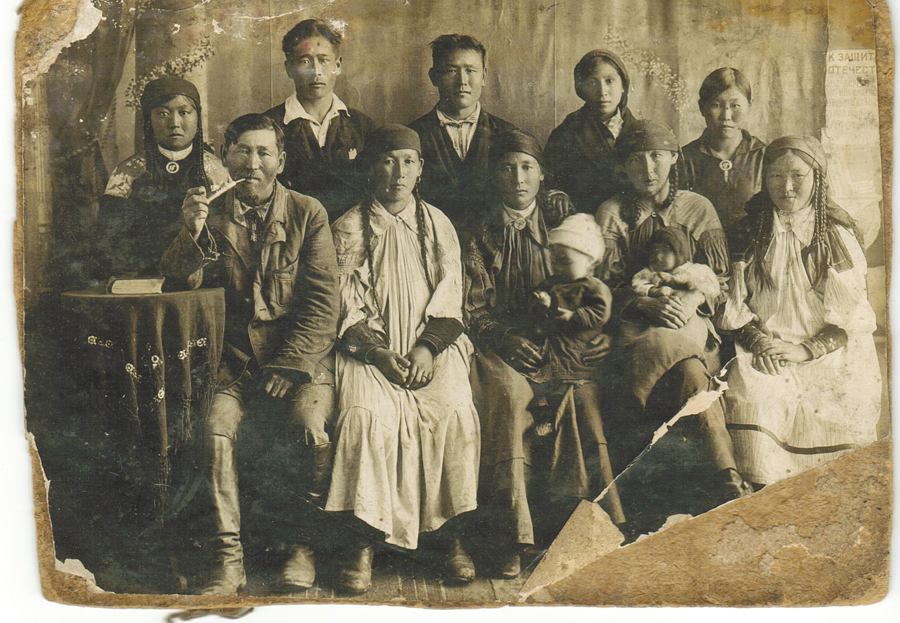
First row in the middle with child: Mirgen Irgit’s great-grandmother Anna Sarlina from Arshan aal, Altai aimaghy
Songs
| 1. Pig tug – The clan banner |
| Lyric song (yr), Khyzyl people, Khyzyllar aimaghy, as sung by Oktiabrina Abdorina. From a recording in 1970 at the archive of the Khakas Radio, Abakan. |
- Altyn Tan Tayas: voice, topchyl-khomys
- Tülber Pögechi: voice, aghas-khomys
- Albychak Sayn: voice, yykh
- Aycharkh Sayn: voice (khai in küülîp style), chatkhan
- Lunic Ivanday: voice (khai in kharygha style), tüür
- Mirgen Irgit: voice, khongyros
|
| The pig tug was the banner with the sign (tamgha) of the clan (söök). This banner would hang firmly fixed above the entrance of the dwelling. When the banner had come lose or hung askew, it meant the clan had ceased to exist: “Let our banner always stand straight up and never come loose, so that the people will remain healthy and safe.” |
| In Soviet times such songs were forbidden. People could be repressed for singing it. Oktiabrina Abdorina has received this song from her mother Sofia and performed it for the first time at an aitys (singing contest) in the 1970s. |
|
| 2. Pasarai – The young man Pasarai |
| Wedding song (sürgünjîler yry), Saghai people, Askhys aimaghy. Recorded by Aleksandr Kenel in 1940, the manuscript at the archive of the Khakas Research Institute XAKNIIYALI, Abakan. |
- Altyn Tan Tayas: topchyl-khomys
- Tülber Pögechi: aghas-khomys
- Albychak Sayn: yykh
- Aycharkh Sayn: voice (khai in küülîp style), chatkhan
- Lunic Ivanday: voice (khai in kharygha style), tüür
- Mirgen Irgit: voice, khazykhtar
|
| This is a sürgünjîler yry (wedding song), a song to take an unmarried girl back home. It is addressed to Pasarai, a young man who started living with a girl, without showing intention to marry her. Since the boy’s relatives had not come forward to discuss marriage within three months after he had taken her to his home, they came to his home to take her back. When they arrived at the boy’s residence, they sang this song. |
| In earlier times, it was tradition to kidnap the bride, but only if the boy did not have the same family status or if his family was not able to pay the dowry. |
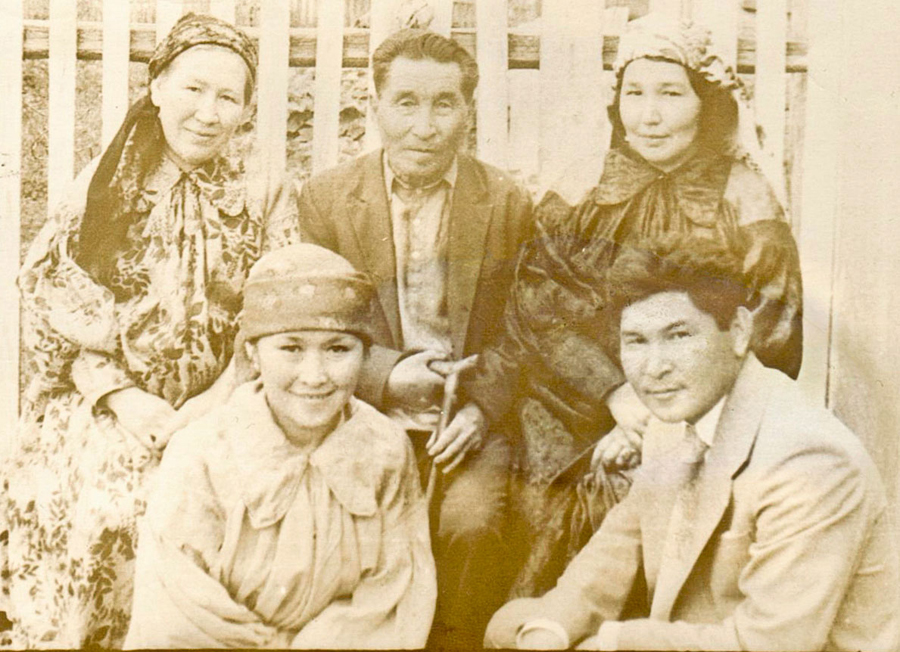 Wedding in Chogharkhy Askhys, Askhys aimaghy
Wedding in Chogharkhy Askhys, Askhys aimaghy
|
| 3. Sürleske – The young man Sürleske |
| Lyric song (yr), Khyzyl people, as sung by Aleksandra Charochkina from Kostino, Sharypovskogo Rayon, Krasnoyarski Kray. Recorded by Aleksandr Kenel in 1948 and published in his collection "Khakas chonynyng köglerî" (Abakan, 1955). |
- Altyn Tan Tayas: voice, topchyl-khomys
- Tülber Pögechi: voice, aghas-khomys
- Albychak Sayn: voice (khai in kharygha style), yykh
- Aycharkh Sayn: voice (khai in küülîp style), chatkhan
- Lunic Ivanday: voice (khai in kharygha style), tüür, sangyros
- Mirgen Irgit: voice (khai in küülîp style)
|
| A song adressed to the young man Sürleske, who does not want to marry. His elder sister tries to convince him by promising material support: “I will give you a calf and dowry, and sew you a lamb fur coat and a white marriage hat (fur cap)”. |
|
|
|
|
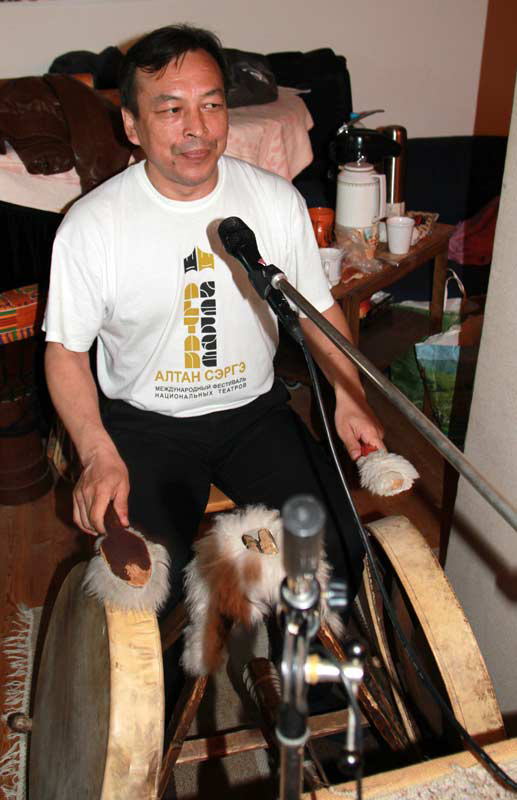 |
Anna Sarlina - right -
just before she got married |
Albychak Sayn, yykk |
Tülber Pögechi, aghas-khomys |
Lunic Ivanday, tüür |
|
| 4. Körbe ool takhpaghy – Takhpakh from Pödör Kurbizhekov |
| Improvised song (takhpakh), Khyzyl people, Naa aal (Ustinkino), Khyzyllar aimaghy. From a recording at the archive of the Khakas Radio, Abakan. |
| - Aycharkh Sayn: voice (narration and khai in küülîp style), chatkhan |
| - “Our settlement is near the Khara Üüs river. / I am a descendant from khaijy storytellers of the Körbe clan”. |
| Pödör (Pyotr) Kurbizhekov (1910-1966), a brother of the singer and storyteller (nymakhchy) Anna Kurbizhekova, is one of Khakassia’s last legendary khaijy (storyteller with khai). He knew at least 103 epic stories, alongside a wide range of other stories and songs. Today he is in high regard for his exceptional narrative creativity, driven by the spirit owner of storytelling. |
| – (See also song no. 5 Khozanakh yry, song no. 14 Kömege köme, and in Vol. III, song no. 13 Khangyra khangyr). |
He performed the takhpakh in a way often used by male storytellers: the text is recited in monotonous küülîp khai style, while the chatkhan provides the melody. Verses then are repeated in an intoned speech style.
In this takhpakh, a series of impromptu four-line verses is set to a fixed melody; Pödör describes his homeland and ancestry.
|
|
| 5. Khozanakh yry – Song of a hare |
Lyric song by an animal (ang-khustar yry) from a kip-chookh story, Khyzyl people, as sung by Anna Kurbizhekova from Naa aal (Ustinkino), Khyzyllar aimaghy. From a recording at the archive of the Khakas Radio, Abakan.
|
- Altyn Tan Tayas: voice, topchyl-khomys
- Tülber Pögechi: voice, aghas-khomys
- Albychak Sayn: voice, yykh
- Aycharkh Sayn: voice, chatkhan
- Lunic Ivanday: khai in kharygha style, tüür
- Mirgen Irgit: voice, sangyros
|
| When her father dies, Poghana Arygh asks Köletke Khan to bring him back to life. Köletke Khan agrees, on the condition that she becomes his wife. He brings her father back to life but the young woman does not fulfil her promise and, in order to escape from him, turns herself into a hare. Her trick works: Köletke Khan cannot find her. But then she fails to transform herself back into a human being and must live on in the form of a hare. Her father, however, is alive in the human world. |
| This song stems from one of her kip-chookh stories, the legend about Poghana Arygh. In it, Poghana Arygh bewails her fate, the loss of control over her life. The song provides a glimpse into the animist worldview of the Khakas people, in which the boundary between the human and the animal world may be easy to transgress. |
| According to the storyteller herself it is a lament (syyt). In the course of its transmission, however, it became a song (yr) because of its lively melody. |
| Anna Kurbizhekova (1913-1990) was a younger sister of khaijy (storyteller with khai) Pödör Kurbizhekov, and was herself a gifted singer, nymakhchy (storyteller without khai) and chatkhan player. |
– (See also song no. 4 Körbe ool takhpaghy).
|
|
6. Khazyngnar – Sacred birch trees
|
| Lyric song (saryn) from Aycharkh Sayn, clan Choon Sayn, Saghai people, Sapron aaly (Safronov), Askhys aimaghy, Abakan. |
- Altyn Tan Tayas: voice, khobyrakh
- Aycharkh Sayn: chatkhan
|
| A song about the sacred birch tree (pai khazyng). It describes the waving tree crowns and how the ritual colourful ribbons (chalama) are being tied to its branches. |
|
7. Aghyr Is – Fast-flowing River Is
|
| Lyric song (saryn), Saghai people, Askhys aimaghy. Recorded by Aleksandr Kenel in 1940, the manuscript at the archive of the Khakas Research Institute XAKNIIYALI, Abakan. |
- Altyn Tan Tayas: voice, topchyl-khomys
- Tülber Pögechi: aghas-khomys
- Albychak Sayn: khai in kharygha style, yykh
- Aycharkh Sayn: chatkhan
- Lunic Ivanday: khai in kharygha style, tüür
- Mirgen Irgit: khazykhtar
|
| - “The river Is always flows rapidly. / Along its wide shores, the strong, black-haired people are always at work. / The river Is always flows fast. / The people living here will never be hungry.” |
A lyric song about Aycharkh Sayn’s homeland and ancestors along the river Is.
|
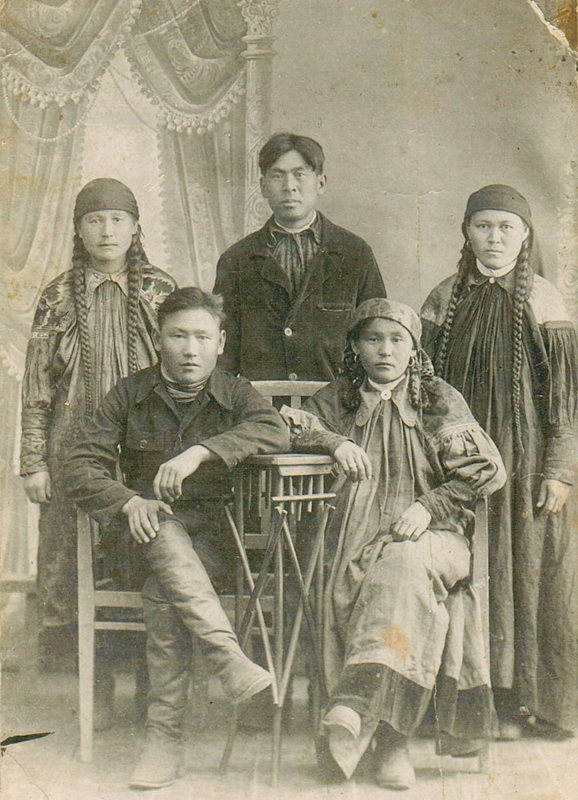 |
 |
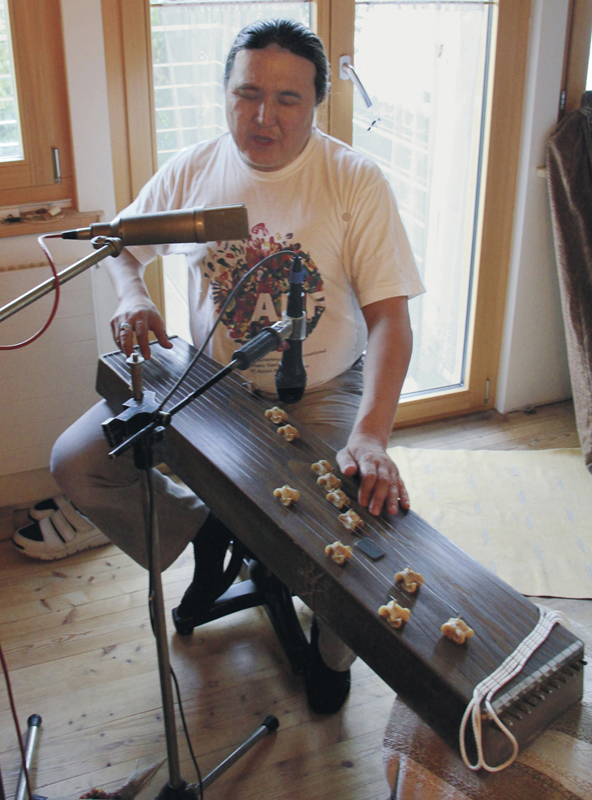 |
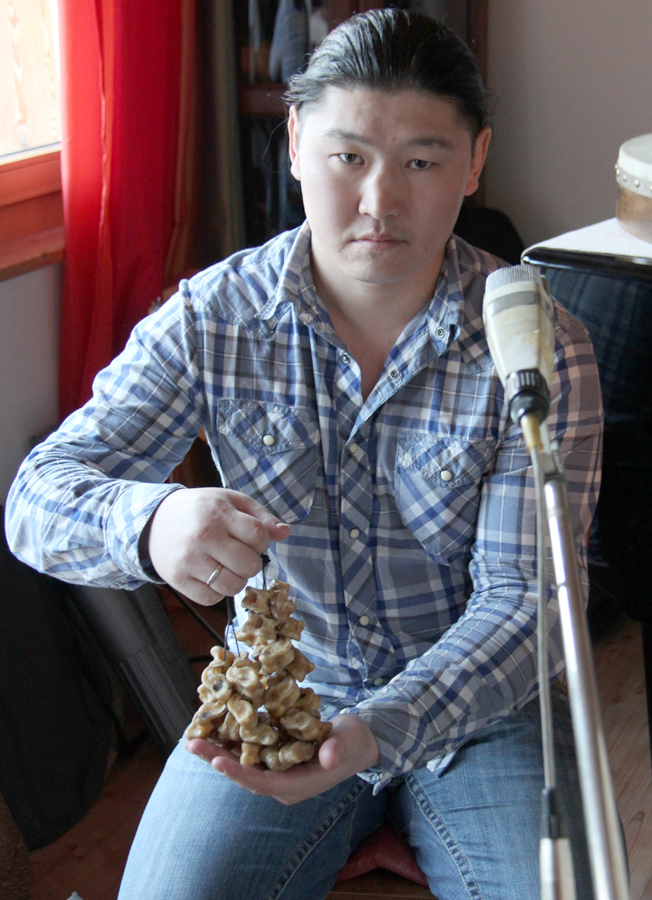 |
Standing left: Anna Sarlina from
Arshan aal, Altai aimaghy |
Altyn Tan Tayas, khobyrakh |
Aycharkh Sayn, chatkhan |
Mirgen Irgit, khazykhtar |
Mirgen Irgit's grandmother Paraskovia Sarazhakova (in the dark dress)
|
8. Sym syydy – Lament of a hazel-grouse
|
| Lament by an animal (ang-khustar syydy), Khyzyl people, Chookhchyl aal (Troshkino), Shira aimaghy. Recorded by Aleksandr Kenel in 1945, the manuscript 167 at the archive of the Khakas Research Institute XAKNIIYALI, Abakan. |
- Altyn Tan Tayas: khobyrakh
- Tülber Pögechi: aghas-khomys
- Albychak Sayn: voice, yykh
- Aycharkh Sayn: chatkhan
- Lunic Ivanday: timîr-khomys
- Mirgen Irgit: sang
|
| - Pazaghy chylda, baa baa, / paza kilerzîng, kharyjakh. / Parym chüreem minîneng / khada khaiylchatkhan oskhas... |
| - “Next year, baa baa, / return as well, dear friend snow. / Because my heart / has melt with you. / In the hot summer, baa baa, / I will lie in the shadow. / In the cooling breeze / I will spread my wings. / Next year, baa baa, / return earlier, dear friend snow. / Because when you leave / my heart will melt with you.” |
| In this lament, the hazel-grouse is suffering from hot weather, as spring has come. It bewails the demise of the cold season and craves for the return of winter. The lament aptly describes the bird’s living habits in summer when it suffers from the heat, as well as its low cry (“baa baa”). |
|
| 9. Saghai köglerî – Saghai melodies |
| Instrumental based on melodies (kögler), Saghai people. After manuscript with recordings in 1940 by Aleksandr Kenel at the archive of the Khakas Research Institute XAKNIIYALI, Abakan. |
- Altyn Tan Tayas: topchyl-khomys
- Tülber Pögechi: aghas-khomys
- Albychak Sayn: yykh
- Aycharkh Sayn: chatkhan
- Lunic Ivanday: tuighakhtar
- Mirgen Irgit: khobyrakh, khai in küülîp style
|
In the 1940s Aleksandr Kenel transcribed countless song melodies without text (kögler). With this improvisation, the ensemble wants to bring back to life the traditional melodies, many of which have fallen into oblivion.
|
|
| 10. Khal ool yry – About a brave young man |
| Lyric song (yr), Khyzyl people, Naa aal (Ustinkino), Khyzyllar aimaghy. From a recording by Albina Kurbizhekova, private collection. |
- Altyn Tan Tayas: voice, topchyl-khomys
- Tülber Pögechi: voice, aghas-khomys
- Albychak Sayn: voice, yykh
- Aycharkh Sayn: voice (khai in küülîp style), yykh
- Lunic Ivanday: voice, tüür
- Mirgen Irgit: voice, khazykhtar
|
| This song tells the story of a young man who was popular among many girls and rejected none of them. He ended up being tied to a pole and beaten to death by the girls' parents. |
|
| 11. Akh aiasnang – About clear days |
| Lyric song (saryn) from Aycharkh Sayn, clan Choon Sayn, Saghai people, Sapron aal (Safronov), Askhys aimaghy, Abakan. |
| - Aycharkh Sayn: khai in küülîp, kharygha and syghyrtyp styles, chatkhan |
In this lyric song in traditional khaijy storytellers’ style, Aycharkh Sayn reflects on his carefree childhood. He recalls how he, as a small boy before being orphaned, had ridden on a horse with his father in front of him. It is a clear day on the steppe, and the small boy concentrates on the bright textile belt his father wears around his waist.
|
| Aycharkh Sayn dedicates it to his late father, performed with throat singing in accompaniment of the box zither (chatkhan). |
|
| 12. Taban – A tough young man from the mountain village |
| Lyric song (saryn), Saghai people. From a 1989 recording by Lunic Ivanday of his grandmother in Baza Pii (Beiska). |
- Altyn Tan Tayas: voice, topchyl-khomys
- Tülber Pögechi: voice, aghas-khomys
- Albychak Sayn: voice, yykh
- Aycharkh Sayn: voice (khai in küülîp and syghyrtyp style), chatkhan
- Lunic Ivanday: voice (khai in kharygha style), tüür
- Mirgen Irgit: voice (khai in küülîp style), khongyros
|
| A young man from Baza Pii village is boasting. |
| - “I was born close to the mountains / but they are nothing compared to me. / I was born close to the snow-capped mountains / but they are small compared to me.” |
Lunic Ivanday, who stems from this mountain village, explains: “Although he was born in the mountains and knows their power, he still considers himself superior to them!”
A song by Lunic’s grandmother, now 93 years old, who has raised him. She sang and played the chatkhan while his grandfather accompanied her on the balalaika (triangular Russian lute). |
|
| 13. Chitî khys – Mountain range “Seven Girls” |
| Lyric song (saryn) from Altyn Tan Tayas, clan Tagh Khargha, Saghai people, Chogharkhy Töö (Verkhniaia Teya), Askhys aimaghy, Abakan. |
| - Altyn Tan Tayas: voice, aghas-khomys |
| - “May my instrument with its rustling strings / burst into an eruption of colourful blossoms. / May the songs I sing / speak with your trees...” |
| Mountain spirits, in particular those of the Chitî khys mountains range, are known for their endowment of a supernatural gift for singing, mostly to women. |
| A wish-praying song, in which the performer wishes a higher power to grant something. Altyn Tan Tayas addresses the female spirit owner of the Chitî khys mountain range near the remote settlement where she grew up. She hopes to reach the spirit with her music and to encounter her. |
|
| 14. Kömege köme – Snow piles on snow piles |
| Lyric song (yr), Khyzyl people, as sung by Anna Kurbizhekova from Naa aal (Ustinkino), Khyzyllar aimaghy. From a recording at the archive of the Khakas Radio, Abakan. |
- Altyn Tan Tayas: voice, topchyl-khomys
- Tülber Pögechi: voice, aghas-khomys
- Albychak Sayn: voice, yykh
- Aycharkh Sayn: khai in küülîp style, chatkhan
- Lunic Ivanday: khai in kharygha style, tüür
- Mirgen Irgit: voice |
| - “Countless times I went to the taiga, / taking lots of wild from there. / The taiga after all raised me / like a mother and father.” |
| In this song she narrates of a successful hunter who has shot already ninety-nine bears, but wants to shoot another one. His companion tells him not to do so, as one should never kill hundred bears. The hunter, though, believes he can do so, because he is so familiar with the taiga that he considers it as parents who raised him, and its wildlife hence as his rightful inheritance. But when finally he does shoot his hundredth bear, he is unable to kill it. His companions’ insight proves to be correct |
| . – (See also song no. 4 Körbe ool takhpaghy). |
|
| 15. Chalamalar – Spring ribbons |
| Instrumental based on melodies from a song (kögler), Saghai people. After manuscript with recordings from 1940 by Aleksandr Kenel at the archive of the Khakas Research Institute XAKNIIYALI, Abakan. |
- Altyn Tan Tayas: khobyrakh
- Tülber Pögechi: aghas-khomys
- Albychak Sayn: yykh
- Aycharkh Sayn: chatkhan
- Lunic Ivanday: syylas, timîr-khomys
- Mirgen Irgit: sang, khazykhtar |
| This instrumental improvisation evokes the ritual of tying ribbons (chalama) to the sacred birch tree (pai khazyng) at the occasion of the chyl pazy ceremony for the beginning of the new year at the spring equinox, about the 20th of March. |
| In the 1940s Aleksandr Kenel transcribed countless song melodies without text (kögler). The ensemble here brings some of them back to life. |
|
| 16. Saaskhan yry – Song of a magpie |
| Lyric song by an animal (ang-khustar yry), Khaas people, as sung by Ivan Takhtarakov from Chookhchyl aal (Troshkino), Shira aimaghy. Recorded by Aleksandr Kenel in 1945, the manuscript 167 at the archive of the Khakas Research Institute XAKNIIYALI, Abakan. |
- Altyn Tan Tayas: voice, khobyrakh
- Tülber Pögechi: aghas-khomys
- Albychak Sayn: voice, yykh
- Aycharkh Sayn: voice, chatkhan
- Lunic Ivanday: khai in kharygha style, tüür
- Mirgen Irgit: voice, müüs
|
| - “May you grow up and wear a black-and-white coat, my child. / May you grow up and eat people’s pulp, my child. / May you grow up and wear a sikpen with a black hat, my child. / May you grow up and eat people’s porridge, my child“. (1) |
| (1) |
“Black-and-white coat“: the magpie’s adult black-and-white plumage; “People’s pulp”: human faeces; Sikpen: coat for spring and autumn, made of black cloth embroidered with coloured silk, worn by young women. |
|
| This song has the characteristics of sung well-wishing poetry (alghys). The song’s persona, a female magpie, wishes her chicken to grow up healthy and live a good life, exactly as Khakas people do for their newborn and young children, a fine example of the Khakas animist worldview in which non-human worlds are parallel to the human one. |
|
| 17. Ügü syydy – Lament of an owl |
| Lament by an animal (ang-khustar syydy), Saghai people, as sung by Khyrghai Sagalakova from Ulugh Nonyp (Bolshoi Monok), Pii aimaghy. From a 2000 recording by Altyn Tan Tayas, Aycharkh Sayn and Liesbet Nyssen. |
| - Aycharkh Sayn: khai in küülîp style |
| - “If only I hadn’t red eyes / I would marry a Khan’s daughter. / If only I hadn’t hairy legs / I would marry a human beauty." |
| In this lament the owl aptly characterizes its own species. It provides also a glimpse into the animist worldview of the Khakas people, in which the boundary between human and animal worlds may be easily crossed. |
|
| 18. Pai ool yry – Song of a rich young man |
| Lyric song (yr), Khyzyl people, Naa aal (Ustinkino), Khyzyllar aimaghy. From a recording by Albina Kurbizhekova, private collection. |
- Altyn Tan Tayas: voice
- Tülber Pögechi: aghas-khomys
- Albychak Sayn: voice, yykh
- Lunic Ivanday: tüür
|
| This is a song with a courting topic. A young man from a rich stockbreeder lineage boosts that he lives in the richest house of the settlement and can get any horse or girl he wants, because his father is the richest cattle and horse breeder around. |
| It has a lyrical, elaborated melody with pronounced rhythms, typical for the Khyzyl people. |
|
| 19. Törîk syilaany – Gift from the High Sky |
| Lyric song (saryn), Saghai people. From a recording from private collection. |
- Altyn Tan Tayas: voice, topchyl-khomys
- Tülber Pögechi: voice, aghas-khomys
- Albychak Sayn: yykh
- Aycharkh Sayn: chatkhan
- Lunic Ivanday: khai in kharygha style, tüür, khongyros
- Mirgen Irgit: voice, khazykhtar |
| This is a religious song by the Khakas “about our land, given to us by the High Sky, Khan Tigîr”. |
|
| 20. Khomyzym – My lute |
| Lyric song (saryn), Saghai people, Baza Pii (Beiska), Askhys aimaghy, transmitted orally. |
- Altyn Tan Tayas: topchyl-khomys
- Tülber Pögechi: aghas-khomys
- Albychak Sayn: voice, yykh
- Aycharkh Sayn: khai in küülîp and kharygha styles, yykh
- Lunic Ivanday: khai in kharygha style, tüür
- Mirgen Irgit: voice, sangyros |
| “It is a song about the khomys and the chatkhan, which were handed down to us by our elders and which we are playing now. May they remain for our children, so that they will play on them, too.” |
In his childhood Lunic Ivanday heard this song from his grandmother, now 93 years old, who has raised him. She sang and played the chatkhan (box zither), while his grandfather accompanied her on the balalaika (triangular Russian lute). She had a song about the two main Khakas musical instruments, the chatkhan and the khomys.
Later, as an adult, Lunic remembered the song, but only the words, so he created a fitting melody to it. |
|
Performing arts
The Khakas people have a rich tradition in storytelling, performing epics in poetry and in prose, proverbs, sayings, wise phrases and riddles, fixed and improvised songs, dirges and laments, wedding songs, lullabies, working songs and game songs.
Text always prevails over music. These linguistic tools are means to tell or sing stories in a convincing and persuasive way. Poetry does have the power to enchant the audience, and for this reason it is performed according to fixed rules. Contextually, poetry is formed on observations regarding parallelism between human experience and natural surroundings.
The Mongols also know songs that are existent in verse form, without any refrain proper, with full vocal power and in the highest register. The melody is surrounded by a “coat“; there is sung a range of more than three octaves; the Khakas songs, however, are rather limited, covering frequently only one octave, with that of the Saghais restricted frequently to only one fifth. These songs are always subject to rather strict rules of presentation and performance. The form is quatrains, and the beginning of every single line is determined by the same vowel of the first word. Texts are adopted by other singers, and there are added some new improvisations: in this way, long stories (songs) are generated and created. The Mongolian people definitely sing these long songs when they are out alone in the steppe and only riding rather slowly. The repertory is a symbol of the freedom and the vastness of the Mongolian steppes and also accompanies cyclic rites of the year and ceremonies of everyday life. Long songs are also an integral part of festivities taking place in the round tents. Among the Khakas, however, such songs are not very common, it is further prohibited to sing in the open steppes or in the taiga, as this might attract the evil spirits. The Khakas also do not distinguish between long and short songs. For rites, there are used alghys (prayers, blessings, thanks), and in gatherings and meetings there are performed alghys and takhpakh (improvised songs).
In the Khakas society creativity has a supernatural source; it is conveyed in the dreams of the people. Such gifts and talents are not only handed down in a line (family), but they may also be awarded to individual persons. Due to the gifts provided by the owner spirits, man and woman are gifted. Skilled story tellers of epics (nymakh), as well as singers singing improvised songs, are supported in their performances by the owner spirits.
Every man and woman can be awarded the gift of creativity by a spirit. Skilled and gifted storytellers of epics and singers of improvised song (takhpakh) are supported during their performances by the spirit owners of nymakh, khai, or takhpakh. They receive instructions and inspiration in their dreams, and are inspired and supported while performing.
Songs were performed at all events where people met spontaneously or on organization, but especially at festive family gatherings and singing contests. People were allowed to sing at day and night, but only in and around the house and the village. For this reason, the Khakas, as opposed to the Tuvin, Altaian and Mongolian people, did not sing songs when travelling or riding the horse across the steppes. Singing in steppe, taiga and mountains is prohibited because it attracts evil spirits. The Khakas people therefore, unlike the Tuvans and Mongolians, do not have travel songs. Most songs can be performed by men and women alike, except for the songs that belong to gender-specific activities, such as (lullabies) cradle songs and work songs. In general, however, songs without throat singing are mainly performed by women, whereas epic storytelling using throat singing is more or less limited to men.
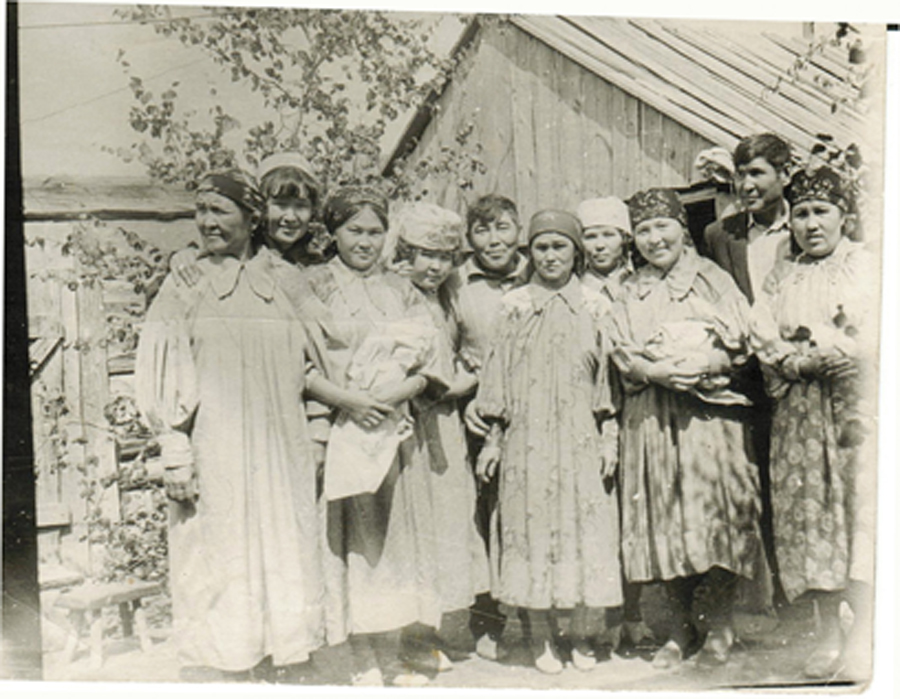
Women at a wedding in Chogharkhy Askhys, Askhys aimaghy
Some songs are integral part of specific occasions like family festivities and year-cycle ceremonies. Blessings (alghys) were recited or sung for welcoming and leave-taking. Love songs, courting songs as well as confirmation of marriage and dowry negotiations formed a rather impressive repertoire. In the context of death, various kinds of dirge (syyt) are sung. In the first year after death ritual dirges are performed: söök syydy (“lament over the corpse”) before and during the funeral and ibîrîg syydy (“lament at a post-funeral wake”) at the wake, to see off the souls of the deceased and thus ease the passage of the deceased into the other world. Later, people sing non-ritual dirges at home in order to commemorate the beloved.
The Khakas people have also songs that are not bound to specific occasions: takhpakh, a song with an improvised text, and saryn or yr, a song with set text and melody. With these songs, performed solo, performers can freely express themselves, sometimes to the accompaniment of a string instrument. Takhpakh are spontaneously improvised texts and give a description of the surrounding nature, one’s home country, a gathering or meeting, or another singer. Takhpakh singers show their talent in special singing contests called aitys. In such competitions two singers alternately compete with constantly improvised verses on a limited number of melodies, and try to outdo each other in originality and wit. Such singers are supported by their spirit owner, who gives them the ability to perform such inspired texts. Set songs are called yr (Khaas, Khyzyl and Khoibal) or saryn (Saghai and Piltîr), having more verses, an elaborated theme, and often more distinguished melodies. The majority of these songs are lyric songs, into which the performer integrates own thoughts and feelings about life and past events; some are work, game, or dirge songs.
The repertoire comprises a small group of dirge songs or laments (syyt) that are designated as lyric songs; dirge songs are ritual songs; laments having improvised texts are performed by a singer and tell of the person deceased and those he has left behind. Personal laments may be taken over by other singers, thus being slowly integrated into the common song repertoire.
Other dirge songs stem from epics or stories (kip-chookh) and constitute the oldest surviving form of the Khakas folklore. Laments are complaints about one’s misfortune, misery or suppression and are also often called “yr” ("song"). These laments are often sung by animals or human beings who have turned into animals and who sing about their harsh living conditions or unfair treatment - another display of the parallels to suppression and the life as vassals shared by the people.
The most prominent Khakas storytelling tradition is epic stories (“epic with a hero”) performed by specialized storytellers at meetings and gatherings during long winter nights – also to accompany souls into other worlds, or before hunting to please the spirit owner of the animal to be given the permission to shoot deer. Performance with throat singing and the box zither or lute was reserved for male performers and called “epic with a horse”. Unaccompanied recitals, being performed with intoned speech voice, are called “epic on foot” and may also be performed by women. An “epic on horse” sets off with an instrumental prelude. Then the storyteller tells the story alternating with throat singing and with repeated text having temporary shifts to a higher or lower tone and with unaccompanied intoned speech. The overtones of the throat singing create an extraordinary timbre texture that brings about the supernatural time-space feeling, in which the epic world comes to life. Every now and then the story is suspended with an instrumental interlude, a blessing, well-wishing expressions, songs or laments.
The most talented storytellers are provided with inspiration by their spirit owners and they are called eelîg khaijy (kaichi). They could endlessly sustain their performance. Such a story could last for several nights in a row, being interrupted only by short breaks. The storytelling tradition was continued without any interruption by Khyzyl storytellers until the 1970s. Among the last great ones were Semyon Kadyshev (1885-1977), who lived among the Khaas people near Lake Shira, and brother and sister Pyotr Kurbizhekov (1910-1966) and Anna Kurbizhekova (1930-1990), who lived along the Üüs river.
Prose stories, which are called “kip-chookh”, are told by women as well as men and include sacred myths about the origin of the world, creator spirits, spirit owners and other supernatural spirits; stories and legends about historical heroes, shamans, ancestors of the tribes; as well as humorous tales and fairytales. The most comprehensive kip-chookh stories, just like alyptygh nymakh stories, “epic with a horse”, include songs, dirge songs, and laments.
Epics (stories) and singing were accompanied by string instruments. In this way, the gait of a horse was imitated, or the adventures of a hero were being emphasized. Hunters used various wind instruments to imitate animal calls and thus attract the desired game. When people played flutes, string instruments or the jew’s harp, it was mainly for personal entertainment. They improvised on standard melodies, or they spontaneously created their own melodies, being inspired by the sound of the environment or closer surroundings.
Such rich creativity is awarded by a supernatural source, conveyed in the dreams of the people. Such gifts and talents are handed down in a line (family) and on the basis of their ancestors. Men and women alike are supported by spiritual powers, which are independent but, however, still responsible for the epics performed in throat singing. These spirits protect and support the “khaijy”, the storytellers of epics, and takhpakhchy, the singers of improvised songs.
Traditional vocal techniques
- Khai (throat singing – guttural singing)
Khai (or kai, as it is called among the Altaian and Shor people) is the traditional form of overtone singing from the north-western Sayan-Altai region, with only the highest and lowest vocal registers being used. It is largely a male vocal technique, though women are known to have performed and to perform it as well. It is inextricably linked with heroic storytelling, epics with a hero / heroine; it is in high esteem and constitutes an important part of the cultural heritage.
Throat singing and overtone singing is a common feature of all southern Siberian Turkic, many Mongolian, as well as some Kazakh peoples. It is also performed by many Turkic tribes in Central Asia. Overtone singing is a very special technique, wherein a single vocalist produces simultaneously two distinct tones. In its clearest (Tuvan and Mongolian) form, one tone is a low fundamental pitch that is sustained like a drone, while the second is a series of flutelike harmonics that resonate high above this drone. A real master may amplify the overtones at the expense of the fundamental pitch, even to the point that the drone becomes inaudible. Another technique often used combines a normal glottal pitch with a low-frequency pulse-like vibration, known as vocal fry. Texts are usually sung in such a vocal fry of about 25-20 Hz. The Shor and the Khakas people do not usually sing their texts in such a fundamental pitch, as they use kharygha more sparingly.
Unlike the Tuvans and the Mongolians, the more northern located Khakas, Altai and Shor people do not express the overtones very much in their khai or kai. Khai is produced by generating a fundamental tone while pressing the diaphragm and slightly pressing together the vocal cords. In this way, a hoarse sound arises, accompanied by soft overtones that change with the vowels of the recited text, thus creating a multi-layered sound hovering above the basic drone. Primarily, the epics are performed together with a string instrument. In the Khakas tradition, however, the overtones are rarely used to create a melody. Khai is not used to show virtuosity, but rather to convey texts in a convincing way; for this reason, this is only rarely performed independently. By using the technique of khai, the storyteller clearly emphasised the text, while at the same time making overtones subtly resonate above the recited text. The overtones help to reinforce the story’s text, as they create an extraordinary timbre texture that brings about the supernatural time-space feeling, in which the epic world and the story come to life.
- Kharygha, kharghyra (from khorlirgha, the Khakas word for snoring) or ulugh chon khai (“khai of the respected elders”) is the lowest sound a human voice can generate. This sound is related to the Altaian karkyra and the Tuvan kargyraa. It rises from the deepest part of the trachea and resonates in the chest. It is used for short episodes in heroic epics.
- Küülîp or küveler means “humming” and sounds an octave higher than kharygha. It is related to the Altaian köömöi, the Tuvan khöömei, and the Mongolian khöömii, but focuses less on producing discernible overtones. It is the main style for storytelling. This style is often simply called “khai” because it is the only style that has survived the Soviet period.
- Syghyrtyp means “to whistle”. This is a style of overtone singing, wherein there are generated tones in the throat that are comparable with the wailing sounds of the wind. Overtones are created between cavity, pharynx and tongue. This style is related with the sygyt of the Altaian and Tuvan people, wherein the highest and brightest tones are generated as the highest register of the voice is used. (In nature, every single tone and sound has overtones; even the wailing of the wind has its overtone vibrations). Whistling is only sparingly used; it is only used for short melodies at the end of phrases; humming (küülîp) is followed by whistling.
The old performers mostly used küülîp to perform stories and songs. Performers today use khai (overtone) mainly for songs and, to a smaller extent, for prayers. Kharygha and syghyrtyp are as frequently used as küülîp.
|
|
Instruments:
|
|
 – aghas-khomys – aghas-khomys
|
- Khomys (string instument)
This is a two-string or three-string lute, related to the Altaian topshur, the Tuvan doshpulur and the Mongolian tovshuur.
The Khakas people play two types of khomys: the aghas-khomys and the topchyl-khomys. Both have a body and neck carved from cedar wood, but while the former has a wooden sounding board from cedar wood, the body of the latter is covered with the skin of wild roe deer, domestic goat, or cattle. The traditional stringing is of twisted horsetail hair, and the strings are tuned a fourth or fifth apart; the three-string khomys is tuned a fourth plus a fifth apart.

 – topchyl-khomys – topchyl-khomys
|
 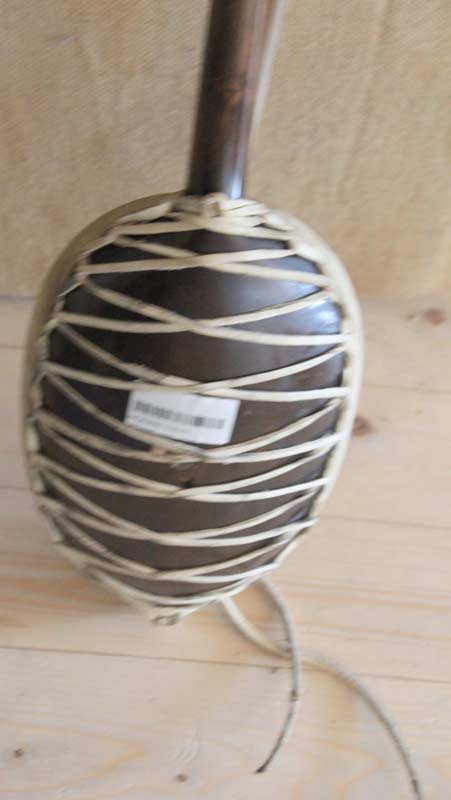 |
- Yykh (string instrument)
This is a two-string fiddle of the Khakas people, related to the Altaian ikili, the Tuvan igil and the Mongolian ikil.
Its body is similar to the khomys but has a longer neck. The body, like that of the topchyl-khomys, is covered with the skin of wild roe deer, domestic goat or juvenile cattle. The strings are made from twisted horsetail hair and are tuned a fourth or fifth apart. It is played with a bow made of willow branch with horsetail hair stringing, and it is coated with larch or cedar wood resin.


|
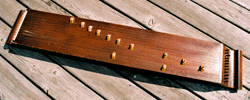
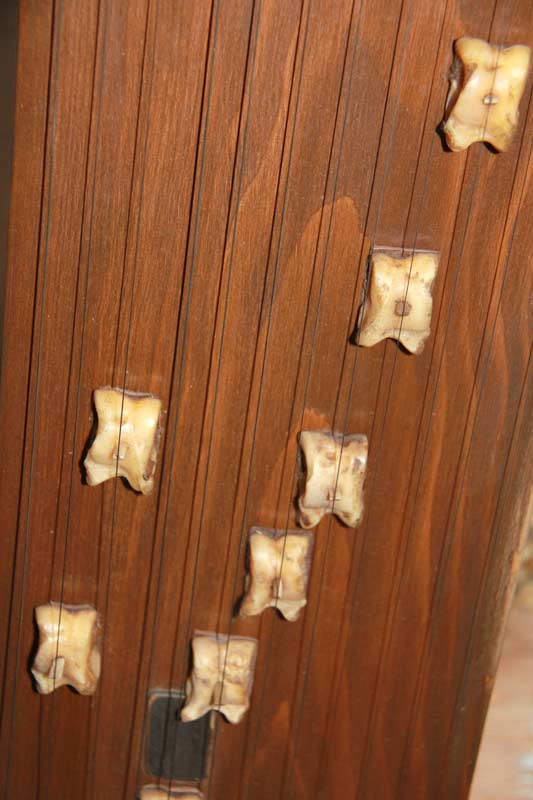
|
- Chatkhan or chadyghan (string instrument)
The chatkhan is the most prominent instrument of the Khakas people. It is a plucked long box zither with six to fourteen strings, distantly related to the Tuvan chadagan, Mongolian yatga, Japanese koto, Chinese quin and Korean kayagum.
The Khakas zither is a 1.5 metres long box from spruce wood, with each metal string running over an individual movable bridge made from sheep’s knucklebone. It is likely to originally have consisted of a short body (about 50 cm long) hollowed out from underneath like an upturned trough, with strings of horsetail hair.
However, in the 18th century it already broadly had its present shape: a long box of nailed boards with 6 or 7 metal strings. It has a rather smooth sound, ideal for performance in intimate company. The chatkhan is tuned in a pentatonic scale, with one or two strings tuned a fifth and/or octave below the lowest melody string, to obtain a drone. Some strings are also pressed to the left of the moveable bridge with the left hand, to raise the pitch. The strings are plucked and strummed to the right of the moveable bridges with the right hand to produce both melody and drone. The left hand is used to press particular strings to the left of the moveable bridge. In this way, diatonic melodies can be played on the pentatonic instrument, as well as the adorning gliding tones and vibratos so typical for the instrument.
Unlike the long zithers (yatga) of the Mongols, who mainly used the long zither at court and in monasteries since strings symbolised the twelve levels of the palace hierarchy, the chatkhan was used to accompany lyrical, historical and epic stories and heroic tales in intimate gatherings of common people, especially at weddings and nocturnal dead wakes.
The chatkhan (like the Khakas lutes) could hold a spirit, and therefore handling and playing was bound by taboos and rituals.

|

|
- Khobyrakh or Shoor (wind instrument)
Formerly an open end-blown flute similar to that used by the Bashkirs and the Caucasians. It was a 30 to 65 cm long, smooth, hollow pipe without finger holes, made of the stem of a large umbelliferous or willow cut on the spot. The Khaas tribe called it “khobyrakh” (lit. “hogweed”, a kind of umbelliferous), while the Saghai and Shor tribes called it “shoor”, like the Altaians, who locally also call it "shagur" or "komurgai" and which is similar to the shoor and the khobyrakh. It has, however, holes at the side and is made from wood. Its length is 30-40 cm.
Nowadays it has a small block with a slit at the top, six finger holes, and it is made of wood veneer (ash, mahogany and other species) or plastic.
|

chervil

|
- Syylas (wind instrument)
An open end-blown flute similar to that used by the Bashkirs and the Caucasians. It is bigger than the khobyrakh (60-80 cm long) with four finger holes to the front and one to the back. It is made from the stem of the big chevil (parasol-like plant, designation for big umbelliferous plants) or from wood. Today it is mostly made from plastic.
Melodies are created via airflow by covering or uncovering the lower end, using a finger. As such a traditionally produced instrument is unsuitable for transport, rather fragile and frail, this instrument is nowadays made from plastics. Today, it often has 3 and sometimes even 6 fingerholes.

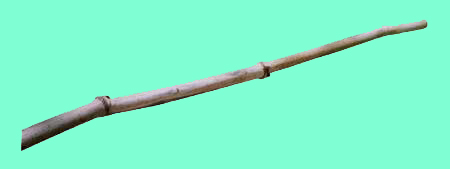 chervil
chervil
|
 |
- Timîr-khomys – jew's harp.
This is a small horseshoe-shaped instrument to which a stiff spring is attached. Today it is made of brass or steel (timîr-khomys literally means “iron utensil”) but in the past it was made of wood.
The player places the frame of the instrument with his left hand to his mouth, touching the front teeth, and taps the spring, which is called ‘tongue’, with his right hand. The instrument’s tongue acts as a vibrator, while the mouth cavity acts as a resonance chamber. The player can vary pitch and timbre by changing the shape of the mouth cavity, opening or closing the throat, and changing the attack on the instrument's tongue.
|

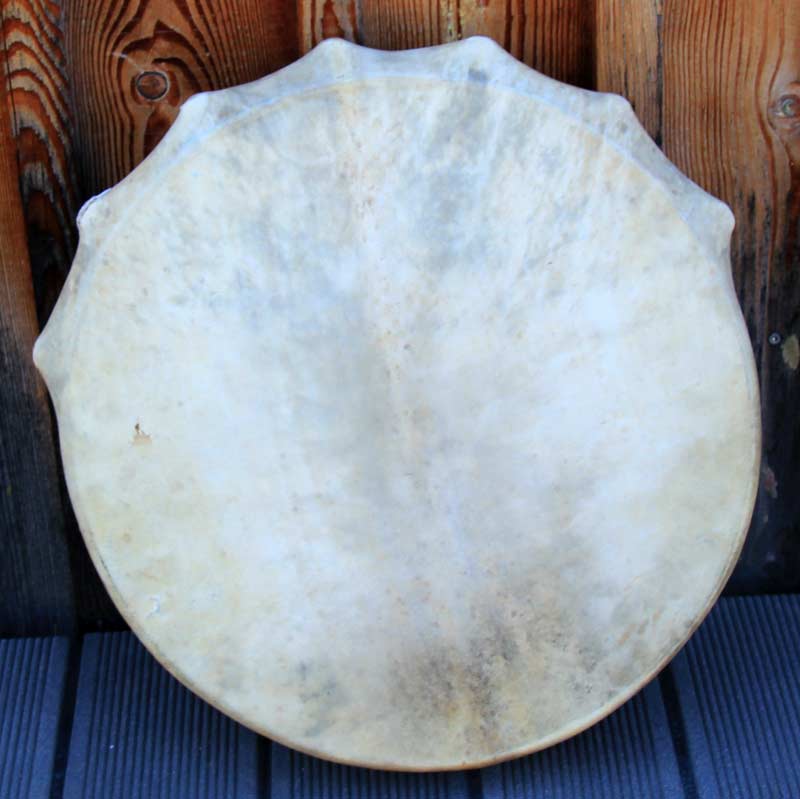
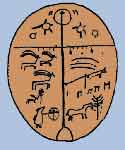
|
- Tüür - single-sided frame drum – shaman’s drum (tungur) – (percussion instrument)
The drum consists of a round wooden frame fixed inside with one vertical and one horizontal wooden stick and covered with the skin of a cloven-hoofed animal. Formerly it was only used as a ritual instrument by shamans (kham). Today it is also used as the main percussion instrument in music ensembles.
When used as a ritual instrument, drawings are made on the outer side of the drumhead, and coloured ribbons (chalama), metal bits and bells are attached to the horizontal stick inside. It is beaten with an orba, a drum stick made of wood and leather.
- Orba – drum stick 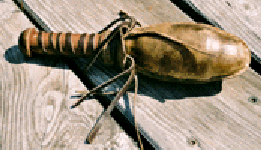
It is made of the urinary bladder of an animal filled with grain and has a handle.
 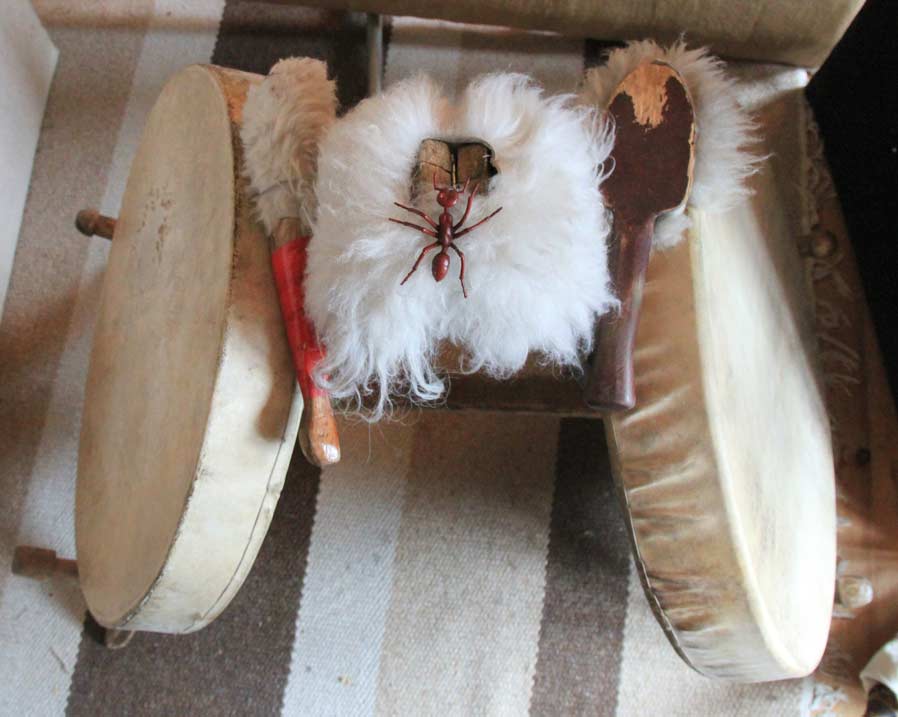
|
 |
- Khongyros (percussion instrument)
Made of leather and filled with grain. |

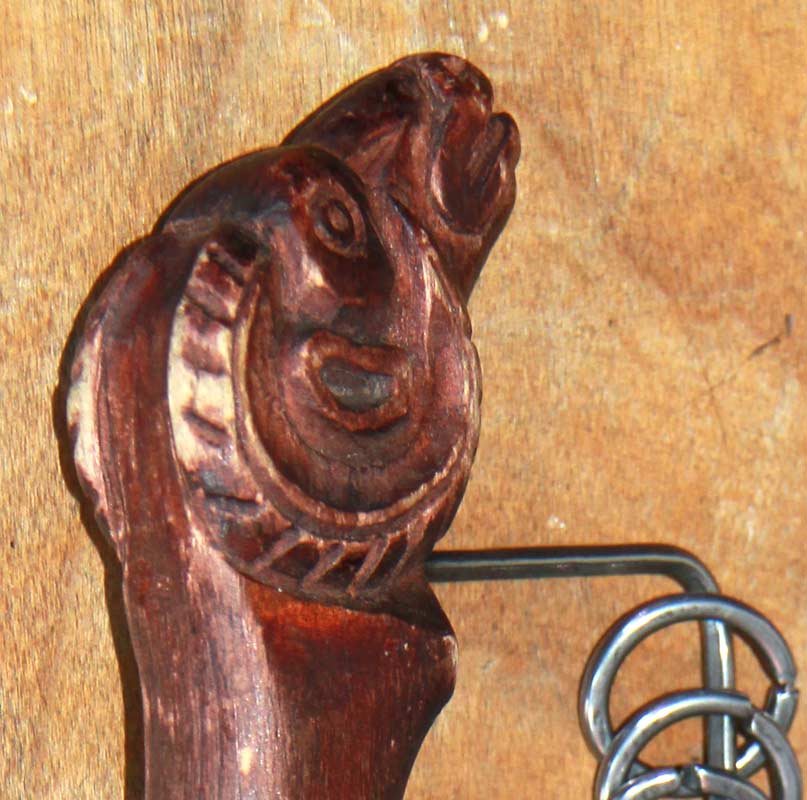
|
- Sangyros (percussion instrument)
Rattle with metal rings; ornamented with horse and ram head |
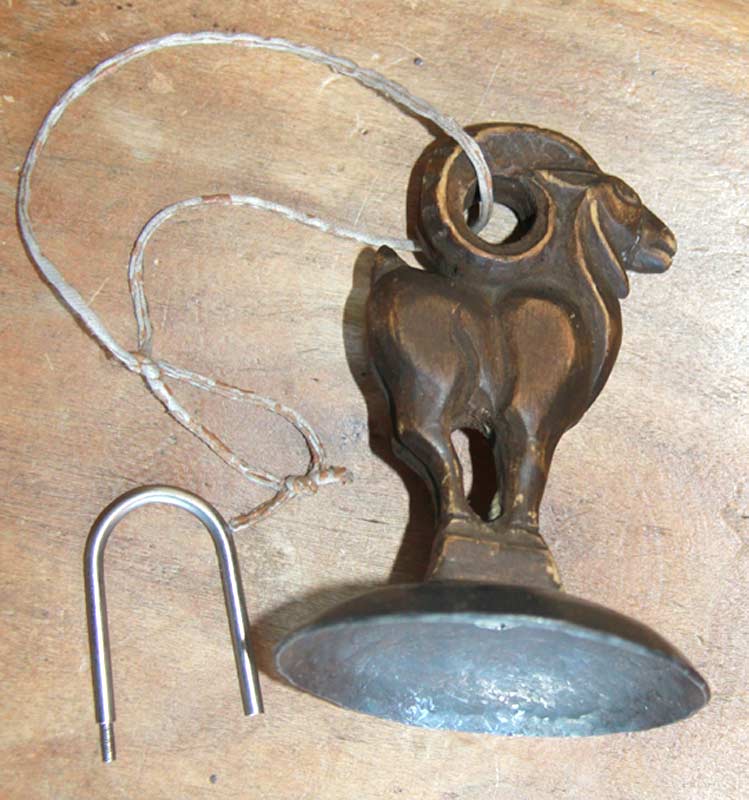 |
- Sang (percussion instrument)
Iron hand bell with a wooden handle in the shape of an ibex. |
 |
- Müüs (percussion instrument)
Rattle made of a cow horn; filled with small stones and closed with leather. |
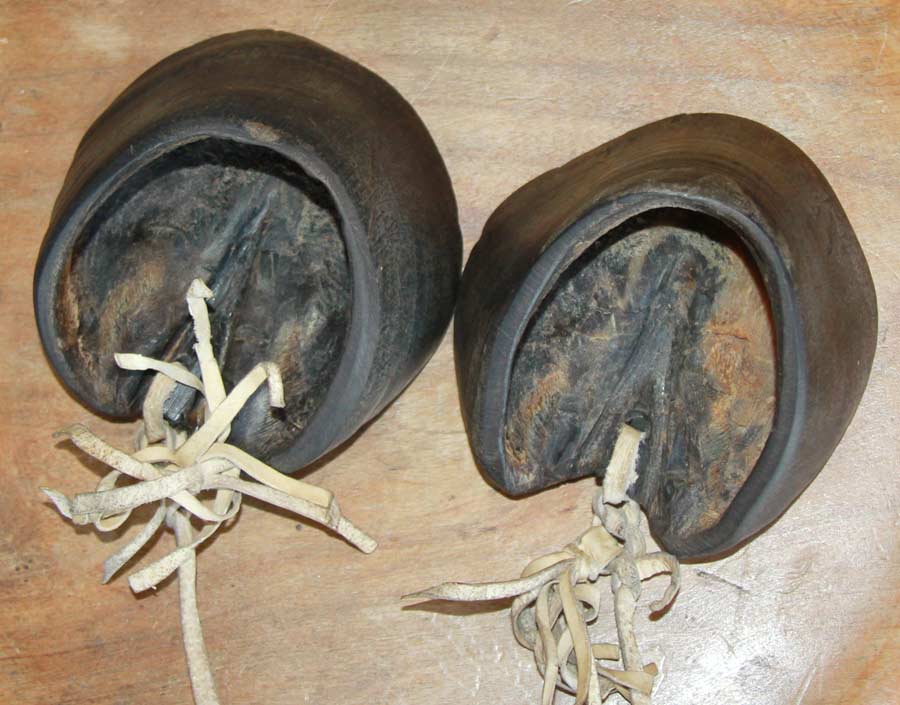
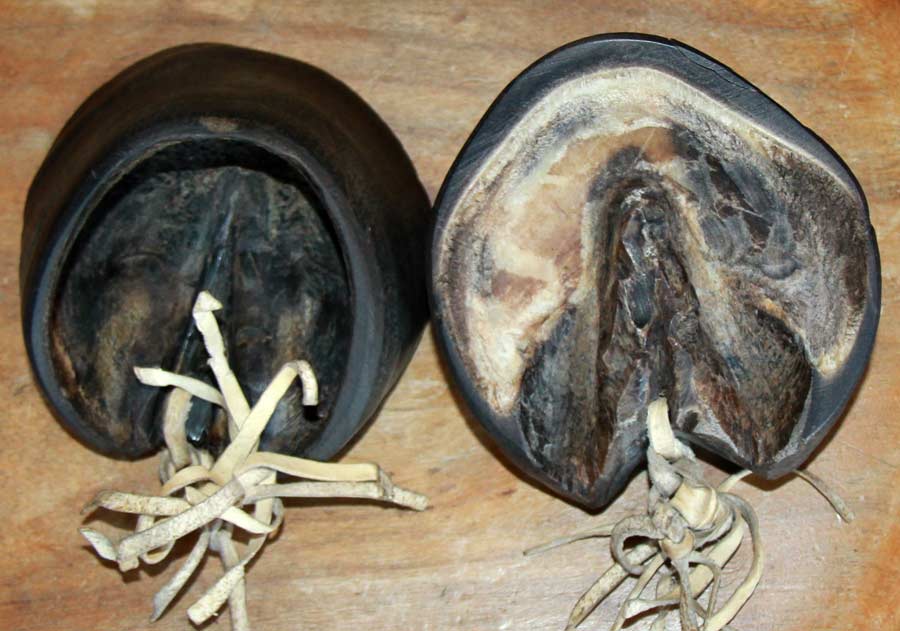
|
- Tuighakhtar - Paddock – hors's hoof (percussion instrument)
Horse hoove clapper. |
|
